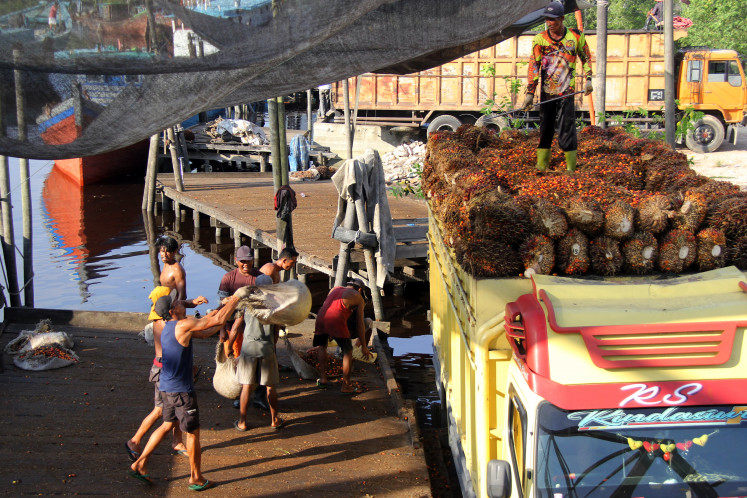Popular Reads
Top Results
Can't find what you're looking for?
View all search resultsPopular Reads
Top Results
Can't find what you're looking for?
View all search resultsFajar Satriadi: Dancer at his peak
In June, dancer Fajar Satriadi will once again appear in a dance drama entitled Romansa Ariah (The Romance of Ariah) at National Monument (Monas) Square, Jakarta
Change text size
Gift Premium Articles
to Anyone
I
n June, dancer Fajar Satriadi will once again appear in a dance drama entitled Romansa Ariah (The Romance of Ariah) at National Monument (Monas) Square, Jakarta. Ariah is a legendary Betawi (Jakarta) tale of an emancipated woman who was also a significant figure in the Tambun farmers' rebellion against Dutch rule in 1869.
Fajar satriadi: JP/Ganug Nugroho Adi
Sadly, Ariah, who is more frequently called Mariah or Mariam, has tended to be relegated to a mythical ghost at Ancol Beach in Jakarta, or depicted as a troubled spirit roaming through horror television dramas.
'Ariah is actually an important woman in our history. She was a female fighter, not a ghost. Her life and struggle were real,' explained Fajar Satriadi in Sragen, Central Java, recently.
The story of Ariah will see Fajar's involvement in major programs with senior dancers increase. For the last 20 years the dancer, who completed a postgraduate program at the Indonesian Arts Institute (ISI) in Surakarta, has performed in an array of shows.
In 1990, he was the principal dancer in a Suropati drama choreographed by Retno Maruti and Sentot S. Four years later, Indonesian dance maestro Sardono W. Kusumo chose him to play the role of (Prince) Diponegoro in Opera Diponegoro and more recently, he was entrusted by Atilah Soeryadjaya with the character of RM Said (founder of Mangkunegaran Palace) in the colossal drama, Matah Ati.
These lead performances led to various international festivals including in Singapore, Germany, the US, Britain and Japan. Besides showing his stage prowess, Fajar also joined dance workshops in several European countries and the US.
Born in Jakarta on October 16, 1968, Fajar does not have a family background in the arts. His father, Tunggal Tarunadi, was a member of the military and Fajar grew up within the rigid environment of barracks in Halim Perdana Kusuma, where his father worked.
'But my father wanted me to learn to dance. As a fifth-grader, he invited dance instructors to teach me and my two younger siblings at home,' Fajar recalled, while watching a group of dancers perform at the Sangiran Museum in Sragen.
Although he was a soldier, Fajar's father came from a family with a keen interest in Javanese culture. Fajar's grandfather even owned a set of Javanese gamelan musical instruments and played them every day. 'Father used to say that the arts make life suppler, without rigidity. It makes us vibrant and dynamic,' he related.
Moch Jubad and Wisnu Priyadi were his first dance teachers who trained him in classical Javanese dance basics. In senior high school, his father introduced Fajar to Javanese literature, including tembang or poetry singing, babad (chronicles of Java) and the great epics, Ramayana and Mahabharata. During vacations, he was sent to his grandfather's home in Surakarta (commonly known as Solo) to learn Mangkunegaran dances.
'A dancer is no worse than a soldier, a musician, a singer or anything else. Dancing makes one's behavior and character more refined. That's what my father said whenever I hesitated about continuing,' revealed Fajar.
Finishing high school in the 1980s, he still considered joining the Military Academy in Magelang, Central Java. But when he saw his father cry while watching him on stage, Fajar made his final choice and pursued a course of study at the Indonesian Classical Arts Academy (now ISI) in Surakarta.
While there, he was instructed by choreographer Suprapto Suryodarmo, who taught him not only dance steps but also self defense. Fajar also learned meditation from Romo (Father) Pudjo Darmo, and practiced breathing techniques at Tri Makna in Bedugul, Bali. Since his earliest days in dance training, Fajar has routinely conducted laku, which includes meditation, fasting and other ascetic acts.
'A dancer should combine the dimensions of mind and body. If successful, the dance movements rendered will bear soul. In other words, the dancer will have charisma and display a fascinating aura,' Fajar said.
His acts of asceticism were indeed far from simple. As he recounted, he has danced on the summit of Mount Lawu bare-chested, immersed his body in a river stream, and meditated amid hundreds of scorpions. Instead of seeking supernatural powers, he claimed he was exploring the five elements of life (water, fire, earth, light and air), to arrive at the dimension of balance according to Javanese belief.
Through this process and long experience, the long-haired dancer reached the peak of his professional career. Fajar said he felt fortunate to have been close to dance masters. Sardono W. Kusumo was the one who introduced him to the professional world. Later, great instructors like Mimi Rasinah, Ketut Ceni, Retno Maruti and Sentot guided him further along his road to
accomplishment.
As a dancer, Fajar reduced the frequency of his performances due to his busy schedule as a guest lecturer and speaker at dance workshops, at home as well as overseas. But he has always been selected to perform on major occasions.
Atilah Soeryadjaya has again chosen Fajar for her work in June, Romansa Ariah, despite the fact that Fajar is an independent dancer and is not a member of a dance studio, theater or dance troupe.
'Beauty is inherent in all traditional dances. In classical Javanese dances, for instance, the movements reflect what we find in nature. There are waving motions like palm trees blown by the wind, and also heroic movements like a horse going into action,' he added.










